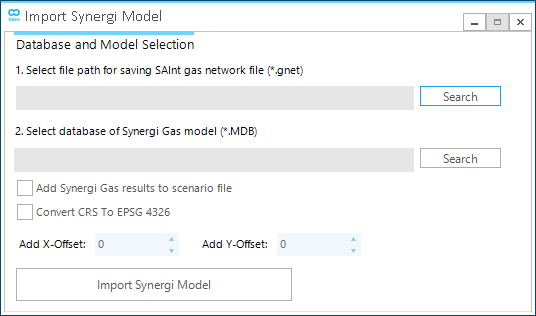Import a Synergi Gas mdb File
This guide provides step-by-step instructions on how to import a Synergi Gas model in SAInt. SynergiTM Gas by DNV is a robust, versatile, and mature hydraulic modeling software tool specialized in simulating natural gas gathering, transmission, and local distribution systems.
Synergi Gas objects are mapped into SAInt objects, and as much original information as possible is transferred. There is no need to install any extra software package, as everything needed is shipped with the standard installation of SAInt.
1. The import procedure
The SAInt Synergi Gas importer procedure is straightforward. It requires the user to provide only one input, i.e., the model *.MDB file, and a small set of options.
1.1. Launch the Synergi Gas importer
Within an active project, select from the "Network" tab (see Figure 1). The window of the Synergi Gas importer opens (see Figure 2).


1.2. Specify the input model and the output network
Once the window of the importer is accessible, the user must provide the path and the name of the SAInt network *.gnet file where the Synergi data will be converted (see "Field 1" in Figure 2).
The Synergi Gas model *.MDB file must be specified as well. These are the only two mandatory elements to launch the import procedure (see "Field 2" in Figure 2).
Click on Import Synergi Model to run the conversion.
1.3. Set options
The user can perform some optional steps:
-
to import the results of a steady state simulation from Synergi Gas to SAInt, check the box Add Synergi Gas results to scenario file. This will map the calculated node pressure to SAInt’s nodal property
PREFand branch propertyQREF. After running the simulation in SAInt, it will be possible to compare the results with such reference values for model validation purposes. -
to convert the Synergi Gas model coordinates to SAInt reference coordinate reference system, check the box Convert CRS To EPSG 4326. The model is displayed on a Cartesian Map View if this option is not selected.
-
perform a rigid translation of the original model by applying a user-defined offset to the x- or y-axis. Values are assumed to have the same units of measure as the original ones.